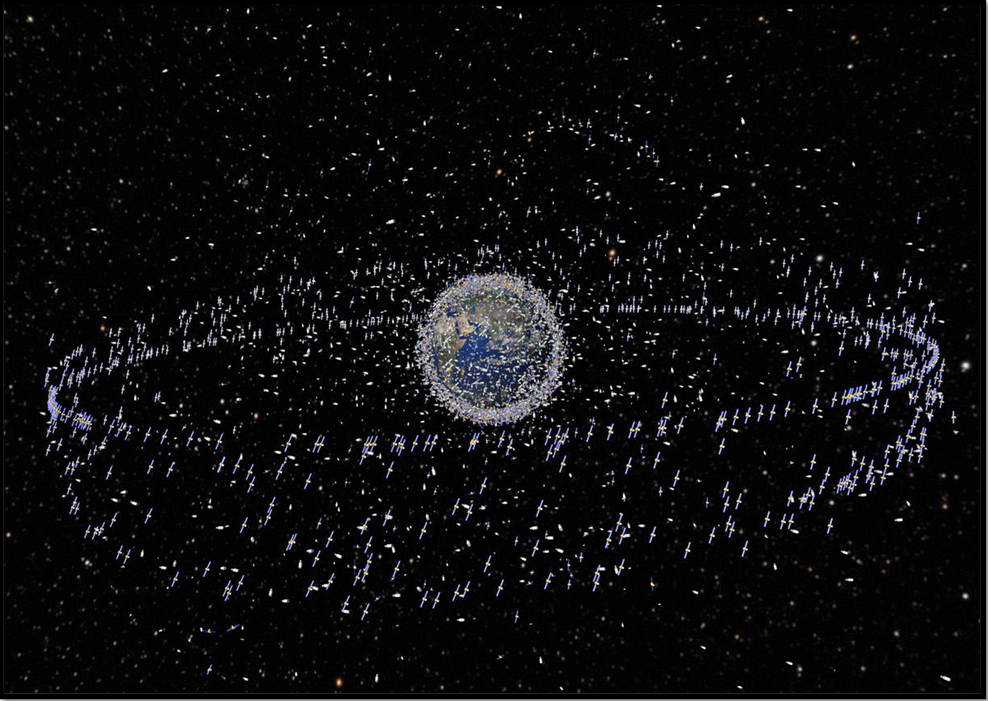ISRO’S ‘ZERO ORBITAL DEBRIS’ MILESTONE
Syllabus:
- GS 2: Achievements of Indians in science & technology; indigenization of technology and developing new technology.
- Awareness in the fields of IT, Space, Computers, robotics, nano-technology, bio-technology and issues relating to intellectual property rights.
Focus:
- The rise in satellite launches has led to a new crisis for spacefaring nations: space debris, which ISRO’s recent mission successfully mitigated by leaving ‘zero orbital debris’.
Source: The Hindu
Understanding Space Debris
- Space Debris Overview: Commonly known as space junk, it includes all non-functional or discarded human-made objects in space, such as defunct satellites, spent rocket stages, and fragments from past collisions.
- Size and Types: Ranges from large items like decommissioned satellites to minute particles like paint flecks shed from rockets.
- Predominant Locations: Most space debris orbits within the Low Earth Orbit (LEO), up to 2,000 kilometers above Earth, with some in Geostationary Orbit (GEO), approximately 35,786 kilometers above the Equator.
Current Space Debris Statistics
- Tracked Debris: According to the ESA’s Space Environment Report 2022, over 30,000 pieces of space debris are actively monitored.
- Micro Debris: Estimates suggest around 200,000 pieces range in size from 1 to 10 cm, with millions of even smaller fragments.
- Large Objects: There are about 34,000 objects larger than 10 cm in various orbits.
- Growth Rate: The number of active satellites surged to about 6,718 by 2022, reflecting an increase of nearly 2,000 satellites within a year, contributing further to the potential for space debris.
PSLV-C58/XPoSat Mission Success
- The Indian Space Research Organisation (ISRO) achieved nearly zero debris from its PSLV-C58/XPoSat mission.
- ISRO transformed the fourth stage of the Polar Satellite Launch Vehicle (PSLV) into the PSLV Orbital Experimental Module-3 (POEM-3).
- After delivering satellites into their target orbits, POEM-3 was de-orbited from 650 km to 350 km, facilitating atmospheric re-entry.
- The stage was “passivated,” meaning all remaining fuel was disposed of to prevent accidental explosions.
- This approach minimized the risk of creating new orbital debris by ensuring the stage re-entered the Earth’s atmosphere and disintegrated.
PSLV Orbital Experimental Module-3 (POEM-3) Overview
- Developed by the Vikram Sarabhai Space Centre, POEM-3 uses the spent fourth stage of the PSLV as an orbital platform.
- It is equipped with solar panels, a lithium-ion battery, and a navigation, guidance, and control system.
- The module includes Sun sensors, a magnetometer, gyroscopes, and communicates with ISRO’s NaviC satellite constellation.
- POEM-3 can perform various in-orbit scientific experiments, thanks to its onboard telecommand system.
- Initially tested during the PSLV-C53 mission in June 2022, POEM has demonstrated the viability of reusing rocket stages.
POEM-3’s Contributions to Space Debris Mitigation
- By lowering its orbit to 350 km, POEM-3 experienced increased atmospheric drag, hastening its descent.
- The module featured payloads from multiple research institutes and private firms to conduct scientific experiments.
- Upon completing its mission objectives, POEM-3 was deliberately re-entered into the Earth’s atmosphere, burning up and leaving no trace in orbit.
- This practice exemplifies proactive debris mitigation, setting a precedent for future missions.
- Continuous tracking by ISRO’s network ensured precise monitoring and control over POEM-3’s final phase.
| Initiatives to Address Space Debris
International Guidelines and Coordination
Research and Technology Development
Debris Tracking and Monitoring
De-Orbiting Technologies
Private Sector Initiatives
National Initiatives and Start-ups
|
Risks Posed by Space Debris
- Space debris travels at speeds up to 27,000 km/hr, posing severe risks to satellites, space stations, and other orbital assets.
- Debris primarily consists of defunct satellites, rocket fragments, and residuals from satellite collisions or missile tests.
- The low Earth orbit (LEO), stretching from 100 km to 2,000 km above Earth, hosts the majority of orbital debris, making it a congested and hazardous area.
- Such debris can trigger cascading collisions, leading to an exponential increase in smaller debris fragments.
- The absence of stringent international laws specifically for LEO debris management necessitates adherence to the Space Debris Mitigation Guidelines by spacefaring entities.
Source:The Hindu
Mains Practice Question:
Examine the measures taken by ISRO to ensure zero orbital debris in its PSLV-C58/XPoSat mission. Discuss the role and functioning of the PSLV Orbital Experimental Module-3 (POEM-3) in these efforts. Evaluate how such initiatives contribute to global space debris mitigation. (250 words)
Associated Articles:
https://universalinstitutions.com/isros-next-gen-launch-vehicle/




